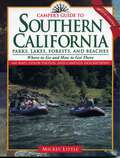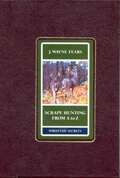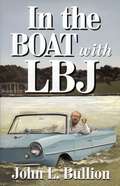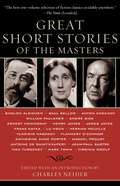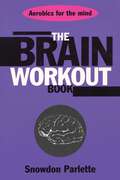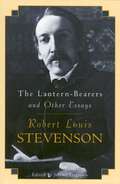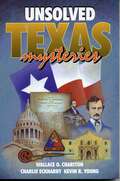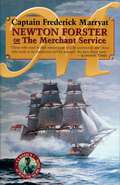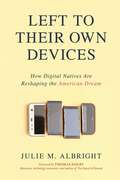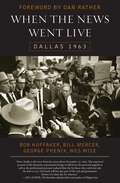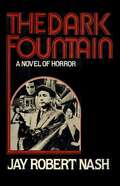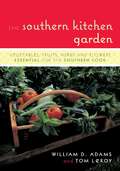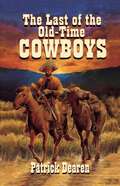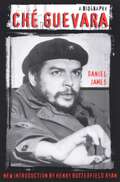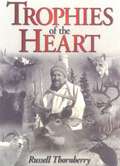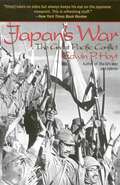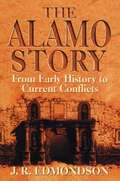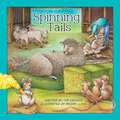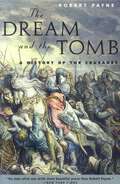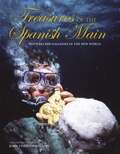- Table View
- List View
Camper's Guide to Southern California: Parks, Lakes, Forest, and Beaches
by Mickey LittleBetter than dry matches on a rainy night, this new edition locates and describes hundreds of marvelous camping opportunities and recreational activities. Featuring key campground eatures, facilities, and activities, this guide's 160 + maps take you right where you want to go. This edition is packed with maps and information on 87 state and national parks, lakes, beaches, forests, and recreation areas.
Scrape Hunting from a to Z
by Wayne J. FearsScrape hunting, the process of searching out and reading the trails left by bucks scraping out dirt and marking the area of their territories, is one of the truly effective tools in locating whitetails. Fears combines his training as a wildlife biologist and as a master woodsman with his impressive writing credentials to bring us the definitive guide to scrapes.
In The Boat With LBJ
by John L. BullionWhen Waddy Bullion refers to his experience working for LBJ as a tax attorney and business advisor, he calls it "being in the boat." LBJ was the captain; the crew either met his standards for effort and excellence or they got out.
Great Short Stories of the Masters
by Charles NeiderForty-nine short stories, selected for their richness of detail, accurate depictions of human passion, and international scope, fill this collection. The authors include Americans such as Hemingway, Faulkner, Saul Bellow, and Flannery O'Connor, 19th and 20th century Western European giants such as Proust, Sartre, Flaubert, Kafka, Mann, Pirandello, Rilke, and Balzac, Russian icons Tolstoy, Dostoyevsky, Pushkin, Turgenev, and Chekhov, and Asian writers Rabindranath Tagore and Lu Hsun. While many of the names are recognizable (though some, such as Bunin, Lagerlof, Nexo, and Svevo rank among the lesser-known), Neider has favored gems less familiar to the average reader.
The Brain Workout Book
by Snowden ParletteExercising your brain is just as important as working out. If you don't exercise your brain, it will atrophy, at least the part your not using. 'Use it or lose it' is as true of our mental faculties as it is of our physical abilities. Fortunately, most of us do get plenty of stimulation in our daily lives, jobs, leisure activities and relationships. The problem is that our brain stimulation is often not very balanced, and that imbalance can affect your sense of well-being. This book provides exercises for all the major brain functions at several different levels.Inside you will be able to: test your brain fitness level, develop right brain association and creative ability, and improve your logic and numbers skills using left-brain workouts invented by scientists.
The Only Texas Cookbook
by Linda West EckhardtThis cookbook is an exciting patchwork collection of authentic recipes as varied as the ethnic makeup of Texas. No one knows Texas cuisine as well as Linda West Eckhardt, and no one has ever written about it with such authority and charm. The 300 fabulous recipes contained in this book—along with a lifetime of cooking, eating, and researching the best foods Texas has to offer—have established Linda West Eckhardt as the expert on fresh, original, and cost-conscious Texas cooking.
The Lantern-Bearers and Other Essays
by Robert Louis StevensonRobert Louis Stevenson (1850-1894) is best known as the author of The Strange Case of Dr. Jekyll and Mr. Hyde, Treasure Island, and Kidnapped, but his essays comprise an oft-overlooked trove of gems, intriguing in their content and generous in their scope. This collection of nearly three dozen of Stevenson's best essays—the only anthology of its kind— spans his brief life and includes many of his most celebrated pieces and some others previously unpublished.
A Field Guide to Texas Trees
by Benny J. SimpsonThis guide helps you sort out thsi Texas greenery that, in sheer loveliness, is second to none. This descriptive handbook helps you identify the more than 220 trees considered to be native to Texas, plus the 30 speices that have become naturalized.
Unsolved Texas Mysteries
by Kevin Young Wallace O. Chariton Charlie EckhardtWhat happened to the documents captured in the Alamo? Does a ghost actually haunt the state capitol in Austin? Was John Wilkes Booth killed or did he escape and flee to Central Texas? The authors present the known facts and circumstances of these and other mysteries.
The Virginian
by Owen WisterThis classic tells the story of the Wyoming ranch foreman known only as the Virgianian, his courtship of school teacher Molly Starkwood, and his encounters with the murdering cattle rustler, Trampas.
Newton Forster or The Merchant Service
by Capt. Frederick MarryatNewton Forster is a troubled young man who survives impressment into the Navy, imprisonment in France, and a shipwreck in the West Indies before gaining a post on a British East India Company vessel bound for Asia. Forster faces a thrill a chapter—murder, insanity, press gangs, prison, pirates, treachery, and romance.
Left to Their Own Devices: How Digital Natives Are Reshaping the American Dream
by Julie M. AlbrightA sociologist explores the many ways that digital natives' interaction with technology has changed their relationship with people, places, jobs, and other stabilizing structures and created a new way of life that is at odds with the American Dream of past generations. Digital natives are hacking the American Dream. Young people brought up with the Internet, smartphones, and social media are quickly rendering old habits, values, behaviors, and norms a distant memory--creating the greatest generation gap in history. In this eye-opening book, digital sociologist Julie M. Albright looks at the many ways in which younger people, facilitated by technology, are coming "untethered" from traditional aspirations and ideals, and asks: What are the effects of being disconnected from traditional, stabilizing social structures like churches, marriage, political parties, and long-term employment? What does it mean to be human when one's ties to people, places, jobs, and societal institutions are weakened or broken, displaced by digital hyper-connectivity? Albright sees both positives and negatives. On the one hand, mobile connectivity has given digital nomads the unprecedented opportunity to work or live anywhere. But, new threats to well-being are emerging, including increased isolation, anxiety, and loneliness, decreased physical exercise, ephemeral relationships, fragmented attention spans, and detachment from the calm of nature. In this time of rapid, global, technologically driven change, this book offers fresh insights into the unintended societal and psychological implications of lives exclusively lived in a digital world.
Texas Guide to Haunted Restaurants, Taverns, and Inns
by Robert WlodarskiGhosts can be encountered anywhere at any time by any person. Why do some people see ghosts more than others? Who knows? Perhaps as some suggest a few people are more psychic or more tuned in than others.
When the News Went Live: Dallas 1963
by Bob Huffaker Bill Mercer George Phenix Wes WiseFor four reporters (Huffaker, Mercer, Phenix, and Wise) at CBS affiliate KRLD-TV in Dallas on November 22, 1963, there was not a dress rehearsal for what they had to do in the aftermath of the assassination of President John F. Kennedy. They provided the first continuous feed of an unfolding tragedy to millions of people around the world. From the initial shots to the shocking shooting of Lee Harvey Oswald by Jack Ruby, the CBS reporters were responsible for keeping the news live and informative, under the microscope of one of the harshest moments in America's history.
The Dark Fountain: A Novel of Horror
by Jay Robert NashBible-toting Earle Leonard Nelson fancied himself a man of mission. The Lamb of God, in fact, divinely empowered to cleanse the world of sin. But the priesthood that carried him across the country from San Francisco to Buffalo and ultimately into Canada during the 1920s assumed grisly proportions—the brutal strangling and violation of twenty-two helpless and unsuspecting women. Landladies mostly, but each, in Nelson's deranged mind, an incarnation of the Bibilical harlots he both loathed and coveted.Earle Leonard Nelson actually lived. And killed. In The Dark Fountain, famed crime historian Jay Robert Nash tells how and why with chilling realism.Beginning with Nelson's sadistic marriage to a frightened San Francisco schoolteacher, Nash's fictionalized chronicle traces the path of Nelson's bloodlust to its riveting conclusion. His story illuminates not only the dark drives that compel the psychopath to slaughter, but also their effect on a relatively innocent America. While speakeasies, flappers and floozies were staples of the Jazz Age, mass murder was not, and Nelson's rampage shocked and confused an entire nation.Nash captures this sense of national outrage in his vivid portrait of Sergeant John Davis, the detective who stalks Nelson with an obsessiveness equal to that of his prey. Infuriated by Nelson's uncanny ability to escape apprehension, Davis also suffers from the impotence of the outmoded investigative techniques characteristic of the period which Nash describes in fascinating detail.The Dark Fountain completely displays the touch of a master storyteller. Whether mapping the terrible geography of Nelson's disordered mind or the progress of his murderous odyssey, Jay Robert Nash expertly blends horror, suspense and the bizarre to create an atmosphere both repellent and unbearably intriguing.
The Southern Kitchen Garden: Vegetables, Fruits, Herbs and Flowers Essential for the Southern Cook
by William D. Adams Tom LeRoyBrimming with fresh vegetables, herbs, flowers, and fruit, the kitchen garden is a celebration of the seasons from deep roots in the South - at times being the difference between being well-fed or hungry. The kitchen garden has now become fashionable addition to urban, suburban, and country homes. The book contains a planting guide for a variety of garden examples, charts, is essential reading for all gardeners ready to produce food for their tables.
Endangered Species (Mariners Library Fiction Classic)
by Richard WoodmanCaptain John Mackinnon and his ship, the Matthew Flinders, are embarking on their last voyage. Both endangered species, they symbolize the irreversible, quiet decline of the British merchant fleet. But this journey to Hong Kong will prove to be anything but quiet. Internal tensions among the crew provoke unrest and lead to a navigation error, steering them right into the violent, destructive path of Typhoon David. Suddenly the crew of the Matthew Flinders are no longer fighting for their livelihood, but for their very lives.Yet on the same sears, other lives are at stake as well. When Mackinnon feels compelled to rescue a boatload of Vietnamese refugees fleeing to Hong Kong, he sets off an explosive chain of events that will lead to mutiny, confrontation with Hong Kong authorities, and the greatest challenge of his career.
Last of the Old-Time Cowboys
by Patrick DearenFrom true cowhands who stood tall in the saddle as the prototypes of the American myth, historian Patrick Dearen has collected priceless, spellbinding stories of a simpler era when a man's word was his bond and a cowhand rode hard and lived harder. Within the pages of this book these genuine legends who rode through a golden moment in American history live on.
Che Guevara: A Biography
by Daniel JamesThe controversial life and career of Ernesto Ché Guevara (1928-1967) has earned the revolutionary leader admirers and detractors across the world. In his critical biography, Daniel James penetrates the myths that have grown up around Guevara since his death. The biography carefully analyzes the Cold War situations in which Guevara lived and fought, and which turned the young medical student into a guerilla and political theoretician. Ché Guevara: A Biography includes interviews with Guevara's first wife, and extensive information on the revolutionary's early years and family life lacking in other biographies. James also discusses Guevara's actions in Cuba as a leader in the rebel army of Fidel Castro, covering in detail Guevara's military victories, his post-war executions of anti-Castro prisoners, and his criticism of Soviet Communism. This unique and unsparing portrait of Guevara includes and an in-depth examination of his last guerilla campaign in Bolivia.
Trophies of the Heart
by Russell ThornberryTrophies of the Heart is the culmination of the most moving, memorable, and heartfelt hunting stories from the career of one of North America's greatest big game hunters. Thornberry takes us on hunts for the whole range of game the North American continent; however, the focus is on the hunts that had the greatest emotional impact because the greatest trophies of all are the memories that one keeps forever. Trophies of the Heart covers everything from his son's first hunt, to zany and wild stories of taking hunters out to guide. In the tradition of Peter Capstick's stories of the hunting world of Africa, Thornberry has a unique ability to give the reader insights into the hows and whys of big game hunting, while relating all of this in short story fashion.
Japan's War: The Great Pacific Conflict
by Edwin P. HoytTracing the history of Japanese aggression from 1853 onward, Hoyt masterfully addresses some of the biggest questions left from the Pacific front of World War II.
Alamo Story: From Early History to Current Conflicts
by J. R. EdmondsonJ.R Edmondson's The Alamo Story: From Early History to Current Conflicts is the millennium's first book to thoroughly examine the famous "Shrine of Texas Liberty" from its origin as a Spanish New World mission to its modern status.
Spinning Tails
by Tom KniselySpring on the farm means sheep-shearing time! In this enchanting tale, a family of adorable mice learn how sheep fleeces can be dyed, spun, and woven into a blanket. But that wool also looks so soft and inviting to the little mice—surely no one would mind if they take a little for their beds? Featuring the beloved family of mice from The Weaver&’s Surprise,Tom Knisely spins this yarn of their new adventures. What will happen when the weaver runs out of wool for his blanket? Can his mouse friends replenish his supply in time?
The Dream and the Tomb: A History of the Crusades
by Robert PayneThis is a comprehensive account of the eight religious wars between the Christian West and the Muslim East that dominated the Middle Ages. Calling themselves "pilgrims of Christ," thousands of Europeans from all stations in life undertook the harsh and bloody quest to reclaim Jerusalem, the Church of the Holy Sepulchre, and Christ's tomb for Christendom.Robert Payne brings to life every step of the Crusaders' thousand-mile journey: the deprivation; the desperate, rapacious, and brutal raids for food and supplies; the epic battles for Antioch, Jerusalem, and Acre; the barbarous treatment of captives; and the quarrelling European princes who vied for power and wealth in the Near East. An epic tale of the glorious and the base, of unshakable faith and unspeakable atrocities, The Dream and the Tomb captures not only the events but the very essence of the Crusades.
Treasures of the Spanish Main: Shipwrecked Galleons In The New World
by John Christopher FineThis is a story about the lust for gold and treasure," Fine writes. In the 1600s and 1700s, Spain dominated the oceans with its fleet of galleons. Coming to the New World, these ships filled their holds with gold and silver and treasures beyond imagining. The seaway between Spain and the New World was dubbed The Golden Highway. On their journeys back across the seas, many were wrecked on reefs or destroyed by hurricanes. The watery depths now hold their treasures. Today, treasure divers seek their fortunes by attempting--sometimes successfully, sometimes fatally--to retrieve these hordes of riches. In Treasures of the Spanish Main, readers relive each voyage of long ago as well as witness the modern wreck diver's efforts to extract their secrets.Included are: The 1622 fleet * The Concepcion * The Maravillas * The Shipwreck off Jupiter Beach * The San Jose * the 1715 Fleet * and the 1733 FleetThe voyages of centuries ago come alive with Fine's excellent historical detail. Readers will experience the wild storms and the results of unfortunate choices made by long-ago sailors. The eccentric treasure hunters of today, along with those of the past, create a mosaic of suspense and drama on the high seas. A must for everyone interested in pirates, treasure, sailing, history, or just plain fun.
